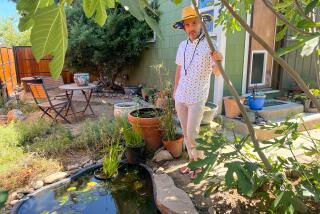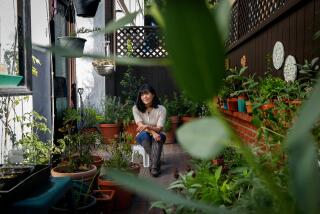Plants for Folks With No Green Thumbs
Here’s some good news for people who have trouble growing houseplants: The problem could lie in where you put the plants rather than in being short a couple of gardening genes.
Light, temperature and humidity have a lot to do with whether a plant thrives or dies. We’ll help you choose the right plants for your home, then help you find the proper location and care for them.
Right plant, right place: Light levels, humidity and temperature vary throughout every home. Match plants to specific conditions.
Light: “Light is clearly the most limiting factor to growing plants indoors,” said Deborah Brown, University of Minnesota extension horticulturist. “All plants need light to manufacture food, but the amount needed varies from one plant to another.”
Most houseplants thrive in moderate to bright, indirect light. Flowering plants and those with colored leaves usually need higher light levels than plants with green leaves. And a select group of plants, including the popular Chinese evergreen and cast-iron plant, will tolerate very low light levels.
Plants show signs of stress when light levels are too low or too high. Weak, spindly growth indicates insufficient light. Variegated foliage will lose all or part of its markings. Signs of too much light are bleached or wilting leaves on plants such as scheffleras, philodendrons, ferns and peperomias. Quick foliage drop, most dramatic on figs (Ficus species), can result from a sudden move from bright light to low.
Even when you find what seems to be the ideal spot for your plants, it might be necessary to move the plant as the seasons--and light levels--change. Plants that thrive in the direct sun of a south- or west-facing window in winter might sunburn if left in the same spot in late spring or summer as light intensifies. In this case, move plants farther from the glass or filter light with a sheer curtain.
Humidity: Most houseplants originate in tropical or semitropical regions, where the air is moist. Many of these plants can adapt to the drier air in our homes, but they do better when humidity is increased--especially during winter when most homes are heated. With insufficient humidity, leaves turn dull and papery. Brown leaf tips are another common symptom.
“One solution is to locate plants that need more humid air, such as ferns, in the kitchen or bathroom, where humidity tends to be highest,” said Matthew Gardner, owner of the Wright Gardner, a San Francisco-based interior-plantscape company.
Another option is to place a humidifier in the room where most of your plants are located. There are several other ways to raise the humidity around plants. Grouping plants keeps the moisture level higher than if air freely circulates around each plant.
Another way is to place plants on a shallow waterproof tray of pebbles partially covered with water. The pebbles provide lots of extra surface area for evaporation. But don’t let the plants sit in the water, or roots could rot.
Many people mist plants to raise the humidity level, but it’s not effective. The water evaporates too fast to benefit plants.
Temperature: Houseplants are “houseplants” because they need the same conditions we do to survive. Most like daytime temperatures ranging from the upper-60s to the mid-70s, and nights that are about 10 degrees cooler. But be aware of cold or hot spots.
For example, on extremely cold winter nights, temperatures on a windowsill could be considerably lower than elsewhere in the room. Keep foliage from touching windows and provide protection with a heavy curtain, or place a piece of cardboard between the glass and the plants.
Few plants tolerate cold drafts or hot air blowing on them. Don’t place plants next to an exterior door or heating duct.
Basic Care: After plants have settled into your home, attention to watering and a few other routine jobs keep them in good shape.
Watering: The one word to describe how to water is thoroughly. Use tepid water and supply enough so excess flows through the soil and out from the drainage hole in the bottom of the pot. But don’t let the plant stand in water collected in the drip saucer for more than a few minutes. Instead, dump the water from the saucer, or if the saucer is large and awkward to maneuver, use a turkey baster to suck up water from the saucer.
How frequently you water depends on the plant and conditions in your home, including temperature and humidity. Some plants, notably ferns, do best when the soil is kept evenly moist. For other plants, such as cactuses and succulents, the soil should dry thoroughly between waterings.
But most houseplants fall in a third category: They do best when the soil dries slightly between waterings. With these plants, allow the soil to dry one-half inch to 2 inches below the surface before watering again.
Precision is impossible here; the specific plant and the size of the container have a significant bearing on timing. Often you can tell when a plant is thirsty--the leaves lose their sheen just before they wilt.
Fertilizing: “Fertilizing falls into the less-is-more category,” Gardner said. He said people have a tendency to overfertilize plants. But too much fertilizer does more harm than good. After all, plants make their “food,” with the help of the sun.
Fertilizer primarily promotes growth. Use a fertilizer labeled for houseplants, and apply it at half strength, Gardner said.
As a guideline, fertilize regularly in spring and summer, when plants are actively growing and can make most use of the added nutrients. Cut back in fall, when growth slows, and stop fertilizing once daylight-saving time ends. And, to prevent root burn, make sure to always moisten the soil before adding fertilizer.
Grooming: Dusting leaves does more than show off plants. “Dust buildup encourages insects, and it also filters the light that reaches leaves,” Brown said.
Especially in winter, plants need all the light they can get to manufacture food.
“Wash leaves individually with a soft cloth moistened with tepid water,” Gardner said. Clean plants with felt-like leaves such as African violets by dusting them with a small, soft artist’s paintbrush.
Do not use commercial leaf-shine products because they create a sticky surface that collects more dust and dirt.
“They make the leaves appear too shiny and unnatural,” Gardner said.
While you’re grooming, check for insects. Mealybugs that appear as white cottony spots are apt to be your worst problem. Use insecticidal soap or, if that’s not handy, daub each bug with a cotton swab dipped in rubbing alcohol. Rinse with tepid water.
This technique also works on other immobile plant pests such as scale insects. Spider mites, another common houseplant pest, spin fine webs on the underside of leaves. Spray them with insecticidal soap. It might take repeated applications to eliminate them.
Start with plants that fit with the conditions in your home, and then provide common sense care. Don’t push your plants to grow, just enjoy them.






